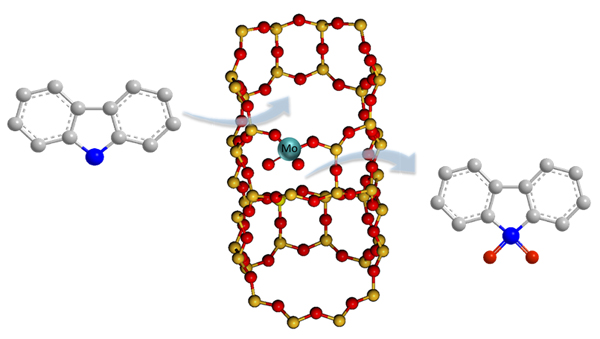摘要/Abstract

本工作通过两步后合成方法,使用脱铝Si-beta分子筛和双(环戊二烯基)二氯化钼(Cp2MoCl2)制备了一系列Mo负载的Mo/beta分子筛材料.通过一系列谱学技术对Mo/beta进行表征分析,发现以beta分子筛为载体材料,可以将孤立的钼物种以(Si-O)2Mo(=O)2的形式稳定限域于BEA分子筛结构中.将所制备的Mo/beta分子筛应用于模拟柴油催化氧化脱硫(ODS)反应中,考察了不同的载体、钼负载量、温度和反应底物随着反应时间的变化,并进行典型动力学分析.源于BEA分子筛结构限域以及结构明确的孤立双氧钼物种,实验所制备的1% Mo/beta催化剂对模拟柴油中二苯并噻吩等模型杂环硫化合物表现出优异的氧化脱除效果,并成功解决了传统Mo/SiO2催化剂钼物种流失、循环稳定性差的缺点,具有工业应用前景.
关键词: 钼物种, 分子筛, 氧化脱硫
A series of Mo/beta zeolite samples with different Mo loadings were prepared via a two-step post-synthesis strategy using dealuminated Si-beta and bis(cyclopentadienyl) molybdenum dichloride (Cp2MoCl2) as precursors. The as-prepared samples were thoroughly characterized by a series of techniques including X-ray diffraction (XRD), the diffuse reflectance infrared Fourier transform spectroscopy (DRIFT), temperature-programmed reduction by hydrogen (H2-TPR), high-resolution transmission electron microscopy (HR-TEM) and scanning transmission electron microscopy (STEM), Mo the K-edge X-ray absorption near edge structure (XANES), the extended X-ray absorption fine structure (EXAFS) and Raman spectroscopy. Dioxo (Si-O)2Mo(=O)2 species were determined to be the dominant Mo species confined and stabilized in structure of beta zeolite. The as-prepared Mo/beta samples were applied as potential catalysts in the reaction of oxidative desulfurization (ODS) from model fuel. The effects of catalyst supports, molybdenum loadings, reaction temperature, and sulfur substrates on the ODS performance were investigated in detail, and typical kinetic analyses of dibenzothiophene (DBT) oxidation were conducted, giving an apparent activation energy value of 50.2 kJ/mol. Owing to the structure confinement, Mo species can be well stabilized within the pores and cages of beta zeolite, and the distribution of which can be regulated by controlling the anchoring sites in the zeolite support to derive well-defined isolated dioxo Mo species. 1% Mo/beta exhibited remarkable oxidative desulfurization efficiency in the removal of heterocyclic sulfur compounds like DBT from the model fuel among all the catalysts tested. Typically, 99.3% of DBT could be oxidized to the corresponding sulfone within 120 min at 333 K. Moreover, 1% Mo/beta showed good recyclability and no obvious activity loss could be observed in five recycles, in significant contrast to poor cyclic stability of traditional Mo/SiO2 catalyst caused by the significant loss of Mo species during desulfurization reaction. Therefore, Mo/beta might be developed as efficient and stable ODS catalysts for future applications under mild reaction conditions.
Key words: molybdenum species, zeolite, oxidative desulfurization
PDF全文下载地址:
点我下载PDF
